

The Cedars of God is one of the last vestiges of the extensive forests of the Lebanon cedar, which once thrived across Mount Lebanon. This forest is a UNESCO World Heritage Site and represents a significant symbol of the country, even featuring on the Lebanese flag.
The nearest international airport to the Cedars of God is Beirut-Rafic Hariri International Airport. Upon arrival at the airport, visitors can choose among several transportation options to reach the forest:
The Cedar forest is accessible by road via several routes, but the main route is through the town of Bsharri. Once in Bsharri, follow the signs to the Cedars of God. There is a parking area near the entrance of the forest.
The best time to visit the Cedars of God is in the spring (April to June) or fall (September to November). During these months, the weather is pleasant for hiking and enjoying the natural beauty of the forest.
Accommodations: There are several hotels and guest houses in and around Bsharri where you can stay. Try to book in advance, especially during the high season or if you plan on visiting during one of the local festivals.
Climate: The weather can be unpredictable in the mountainous region, so be sure to bring appropriate clothing. Wear layers to adjust to the changing conditions.
Conservation: As a protected area, it's important to respect the natural environment. Stay on marked paths and do not remove any plant life or disturb the wildlife.
Guided Tours: Consider hiring a local guide to learn more about the history and biodiversity of the cedars.